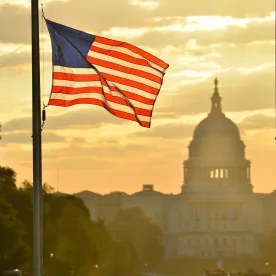The American Rescue Plan Act of 2021 (ARPA), signed into law on March 11, 2021, includes a whole host of requirements and provisions impacting private employers, their employees, and the benefit plans they offer.
Here is a rundown of the Consolidated Omnibus Budget Reconciliation Act (COBRA) and Families First Coronavirus Response Act (FFCRA)-related changes impacting employers.
COBRA Premium Subsidies:
A significant mandate of ARPA impacting employers and their group health plans is the requirement to offer 100% subsidized COBRA continuation coverage to eligible plan participants (defined as "assistance eligible individuals" or "AEIs") between April 1, 2021, through September 30, 2021. There are many nuances (and other technical requirements) associated with this mandate that necessitate quick action from employers (and their group health plans) to comply. To make matters more confusing, certain guidance and regulations are needed from federal agencies, such as the United States Department of Labor (USDOL) and the Internal Revenue Service (IRS), to better understand certain aspects of the COBRA provision of ARPA, yet that guidance is not expected until after April 1, 2021. Nevertheless, we recommend preparing now in order to avoid likely pitfalls.
Who is an AEI
An AEI is any qualifying plan participant who loses, or has lost, health insurance coverage due to an involuntary termination (other than for gross misconduct) or a reduction in hours worked (note: ARPA does not appear to distinguish between a voluntary or involuntary reduction in hours), and who elects continuation coverage to be effective during the April 1, 2021, and September 30, 2021, timeframe. As with COBRA eligibility in general, an AEI will lose eligibility for COBRA subsidized coverage if they become eligible for other group health insurance coverage or Medicare. AEIs are required to notify the plan if they lose eligibility for COBRA subsidized coverage.
Who Must Provide Subsidized Coverage
Employer-sponsored health insurance plans that are subject to federal COBRA requirements or comparable state continuation programs must offer fully subsidized continuation coverage to AEIs between April 1, 2021, and September 30, 2021. To be clear, the requirement to provide fully subsidized continuation coverage for AEIs applies to employers who are subject to COBRA, as well as small employers who are not subject to COBRA but are subject to a state law continuation law, like North Carolina's health insurance continuation law.
What about Reimbursement or Tax Credits?
Employers who comply and provide subsidized coverage as required by ARPA will be reimbursed through tax credits against their quarterly payroll taxes for the costs of the subsidized coverage during the six-month subsidy period. If the tax credit exceeds the payroll taxes owed, it will be treated as an overpayment and refunded to the employer. Employers can also seek the advancement of the credit (to be treated as a refund), such as if the costs of subsidized coverage are expected to exceed the quarterly payroll taxes. Further guidance from the IRS detailing how this process will work is anticipated.
Extension of Election Period for AEIs
Significantly, ARPA lengthens the COBRA election period, and allows individuals whose COBRA election period expired prior to April 1, 2021, to elect subsidized COBRA coverage beginning April 1, 2021, so long as the individual otherwise qualifies as an AEI and remains eligible for COBRA coverage during (some or all of) the six-month subsidy period. This special enrollment opportunity also allows AEIs who previously declined COBRA, or elected but then terminated their COBRA coverage (such as due to premium nonpayment), the ability to elect subsidized COBRA coverage beginning April 1, 2021. Although the election period has been extended and broadened to include more individuals who may qualify for subsidized COBRA coverage, ARPA does not extend the maximum COBRA coverage period (generally 18 months). Thus, it is possible for AEIs to qualify for subsidized COBRA coverage for a portion of, but not all of, the six-month subsidy period. Employers would be well advised to begin identifying those individuals who fall into this category, so that they may timely provide notice to affected AEIs.
Notice Requirements: Plans must provide three types of notices to AEIs (two of which are one in the same, but the timing and recipients are different).
-
General Election Notice: Plans must provide a general election notice to AEIs who first become eligible for subsidized coverage during the six-month subsidy period. This notice must generally notify the AEIs regarding the availability of premium assistance and other specific details about the administration of the subsidized coverage. Plans may update their existing COBRA election notices or may create a new, separate notice to accompany the traditional COBRA election notice. USDOL, in consultation with the IRS, is expected to issue a model notice by April 10, 2021.
-
Special Election Notice: Similar to the General Election Notice, but this notice must be provided to those AEIs who previously elected, but discontinued their COBRA coverage prior to April 1, 2021, or who declined COBRA previously, but are still within their COBRA coverage eligibility period. This notice must be provided within 60 days from April 1, 2021, and AEIs will have 60 days from receipt of the Special Election Notice to elect subsidized COBRA coverage. USDOL, with input from the IRS, is expected to issue a model notice by April 10, 2021.
-
Expiration of Subsidy Notice: The General and Special Election notices provide information to AEIs on the front end regarding their rights to elect subsidized COBRA coverage, whereas this Expiration of Subsidy Notice requirement alerts AEIs that the subsidized aspect of their COBRA coverage will expire on a certain date. This notice must be provided at least 15 days before the subsidy expires and no earlier than 45 days before the subsidy expires. This notice is not required where an AEI becomes ineligible for COBRA coverage due to becoming eligible for group health insurance coverage or Medicare. USDOL is tasked with issuing a model notice by April 25, 2021.
Tax Credits for Providing FFCRA Paid Sick and Family Leave:
ARPA does not renew the requirement that private employers must provide employees with paid or unpaid leaves of absence for reasons related to COVID-19 – as originally mandated by FFCRA almost exactly one year ago. ARPA does extend and expand the availability of payroll tax credits if employers voluntarily provide paid leave consistent with FFCRA and, now, ARPA.
Who: Tax credits are available to private employers with fewer than 500 employees who voluntarily provide qualifying paid leave under FFCRA. It also appears that local government employers may be eligible in similar circumstances for Social Security and Medicare tax credits.
When: Wages that entitle an employer to payroll tax-credits must be paid within a specified period of six (6) months: from April 1, 2021, through September 30, 2021.
What: In short, ARPA expands the qualifying reasons for paid leave (both sick leave and emergency family medical leave) under FFCRA; extends the length of paid leave available; and increases the maximum tax credit associated with that paid leave.
The Details:
-
ARPA broadens the COVID-19-related sick-leave reasons for which an employee would qualify for paid sick leave (and for which an employer could seek related payroll tax credits). The three new qualifying reasons for paid leave under FFCRA include (a) getting tested or awaiting test results or medical diagnosis for COVID-19 (provided that the employee was exposed to COVID-19 or the test/diagnosis was requested by the employer); (b) getting the vaccine; or (c) recovering from an illness or medical condition associated with getting the vaccine. In order to qualify for the tax credit, the employer must provide paid leave for one of these qualifying reasons.
-
The expanded "sick leave reasons" (above) are now included as qualifying emergency family medical leave reasons for paid leave under FFCRA.
-
ARPA eliminates the requirement that the first 10 days of emergency family medical leave be unpaid.
-
It creates a new bank of up to 10 days per employee of qualifying paid sick leave that is available for tax credits for 2021, beginning on April 1, 2021. Thus, the amount of the tax credit per employee has increased from $10,000 to $12,000.
-
Finally, ARPA disqualifies employers from receiving a tax credit if they violate FFCRA, such as the anti-retaliation provisions, or violate the nondiscrimination rules by administering FFCRA paid leave benefits in a discriminatory fashion in favor of highly compensated employees, full-time employees, or employees with greater seniority.
As you might have heard, the ARPA legislation is expansive and includes a variety of other provisions impacting employers, benefit plans, and employees. While this article focuses on the subsidized COBRA and FFCRA provisions, there are a number of other provisions that relate to defined benefit plans, dependent care flexible spending arrangements, executive compensation, and certain industry sectors. Employers are encouraged to contact their legal counsel so they can understand the tax credits and other advantages that can be derived from ARPA, such as with voluntarily providing paid leave under FFCRA, as well as the many new obligations that are likely to present administrative and compliance headaches, if not addressed soon.





 />i
/>i
